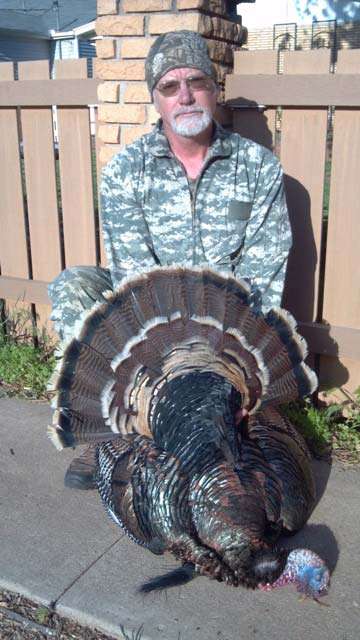One April evening about dark several springs ago, I eased my old pickup to a stop along a wheat field and killed the engine. To my left, along the end of the wheat, a thick fence row of tangled Hedge trees stretched toward the horizon. Off the road a ways, the back side of the hedge row became several acres of cedars, thick brushy overgrowth and tall twisted cottonwoods, carved into odd shaped pieces by a wide muddy drainage ditch. My wife and I had just gotten permission to hunt turkeys there, and the owner said there was a turkey roost somewhere within that small jungle. Joyce and I were beginning turkey hunters and had recently learned about the spring turkey trick known as “shock calling.” I pulled a plastic crow call from my pocket and blew several piercing shrieks into the cool evening air. The notes had barely faded away, when, from somewhere deep in the “jungle,” came the unmistakable raucous gobble of a tom turkey. I was so surprised when it worked, that I nearly dropped the call out the window! Later in the year, we also experienced this same reaction to the loud closing of our pickup door. I remember at the time, I was working on an instructional story for beginner turkey hunters like ourselves, so I contacted then KDWP biologist and wild turkey specialist Jared McJunkin from Emporia, and asked him about this interesting behavior known as “shock gobbling.”
He explained that when turkeys hear a loud noise somewhere in their comfort zone, they often react by gobbling. He equated this response to a “knee jerk” reaction in humans. It seems that only gobblers do this, and, although they will shock gobble at other times of the year, it happens most often in spring when hormones are raging in the toms and they are on-edge and lovesick. Coyote, owl and crow calls are most often used for shock calling to initiate this response, but, as we found out first hand, any loud noise, like the slamming of a car door, can trigger a tom to gobble.
This is a nifty piece of trivia, you might be saying, but how does this relate to spring turkey hunting? In the woods, there are probably very few square feet of earth where deer do not eventually step at least once, so in theory, you could set anywhere in that woods, and eventually get a shot. Your odds of harvesting a deer, however, dramatically increase the closer you are to where the deer travel on a regular basis. By the same token, I know from experience that in the spring, love sick tom turkeys can be called from great distances. My odds of putting turkey in the freezer, however, increase just as dramatically the closer I can be to where the “boys” will be traveling, strutting or tending to their harem of hens. Spring turkeys can be very nomadic, but one fact makes them predictable to a point. As long as they aren’t badly spooked, they will roost the same place, each night, for some time. Shock calling can be a great tool for finding roosting birds, and thus help you as the hunter decide where to set up to the following morning to best intercept them.
That same spring, we also learned that it’s not good to hunt too close to a roost. My sister had been seeing turkeys in a brome field on their place west of Inman. I drove by there one evening and used my crow call, but got no response. Thinking they were certainly roosting toward the center of a patch of trees at the end of the field, we set up our blind in the fencerow above. The following morning, before dawn, we parked in the brome field and got out to walk quietly to the blind. As I closed the pickup door, a tom turkey gobbled from practically above our blind. Turkeys will roost over water if possible, and these birds were in a big spreading cottonwood above a neighbor’s pond, less than 20 yards from the blind. That was an awesome experience as we heard and watched them wake up and leave the roost. The problem was, we never got a shot, and the turkeys never returned! The lesson here is that once you have located roosting toms, keep your distance from their roost as you set up to call or intercept them. I was looking forward to cultivating that small flock on her farm where I have permission to hunt, but our inexperience changed that for the rest of the season.
2023 spring turkey season for youth and disabled hunters runs from April 1 – 11, and several special hunts are planned around the state. Spring turkey archery season runs from April 3 – 11 and the 2023 regular turkey season runs from April 12 – May 31. Turkeys are already moving into their spring territories and toms have begun gathering their harems. Buy yourself an inexpensive crow, owl or predator call, and cruise the back roads some evening. Stop along wooded areas and hedgerows where you think turkeys may be roosting, and blow a few notes to see if you can get a tom to answer. It’s a hoot! (Literally)…Continue to Explore Kansas Outdoors!
Steve can be contacted by email at [email protected].





